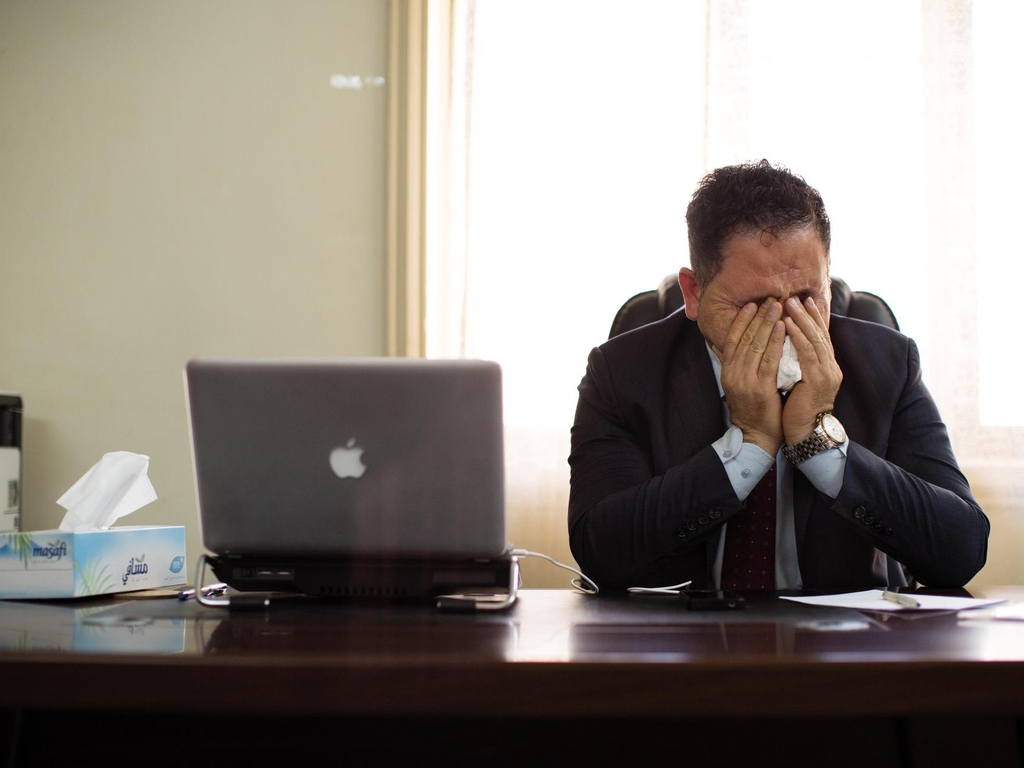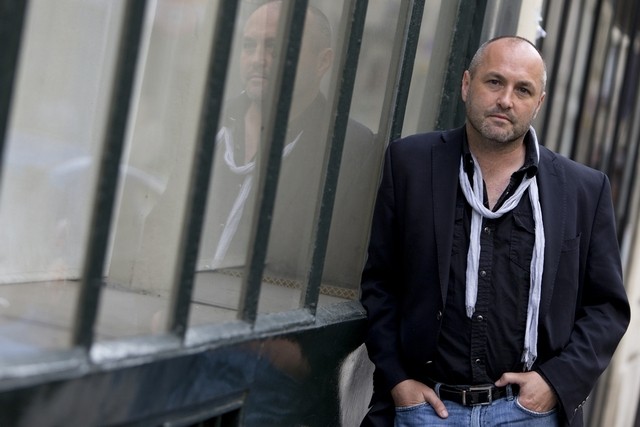It’s a photograph that could have been taken anywhere in the world, and yet is intrinsically Kurdish. A man sits at his well-appointed desk in his business wear. Next to him is a MacBook … and a box of tissues, because Hazhar Omar is sobbing.
“That, to me, is the most meaningful photograph in my book,” says Sebastian Meyer, the American photojournalist who ended up in the middle of an amazing story in Iraqi Kurdistan.
“The picture, for me, totally encapsulates modern [Iraqi] Kurdistan – a man with an expensive watch who wouldn’t look out of place in any capital city in any country in the world – and yet he’s crying because we are talking about his father, who was kidnapped during the Iraqi Kurdish civil war in 1996.

“So on the surface, he’s like anyone else – but deep inside, he carries a pain and history that is uniquely Kurdish. As a metaphor, the photograph really nails Kurdistan.”
“I was photographing survivors of the genocide, mass graves, really horrendous stuff,” he tells The National. “But what was actually on the ground was very different from what I had read about. It had been this violent, povertystricken place, but now they were trying to build skyscrapers, there were business parks, gated communities. It was peaceful, there was actual wealth. A lot of Kurds who had fled to Europe had come back, they’d set up businesses, they were entrepreneurs. So there was a lot more going on than I thought.”Under Every Yard of Sky was published last year, yet its relevance feels timeless. Meyer’s idea, to try and fully explore the roller-coaster narrative of Iraqi Kurdistan through images (and words), was always much more than a photo essay in a cool magazine – it needed context. And it came the first time Meyer arrived in Iraq in 2008 to photograph a project on Saddam Hussein’s Anfal campaign, in which as many as 150,000 Kurds were killed.

And personally, Meyer found a lot going on, too. He struck up a friendship with Kamaran Najm, a Kurdish photojournalist, and the duo became inseparable, covering everything from the militant Kurdistan Workers’ Party in the north of Iraq to the disputed territories in the centre and Al Qaeda police raids.
“We were just running around giddy, super-psyched,” he says, with a laugh. “We’d photograph all day, party all night.”
They set up an agency that could represent Iraqi photographers. Najm called it Metrography – “terrible, terrible name”, jokes Meyer – but it provided images for The New York Times and Time magazine, and one of its photographers, Ali Arkady, won the the top award for war correspondents, the Prix Bayeux-Calvados, for his pieces documenting and exposing human-rights abuses during the Mosul campaign.

And then, one day in June 2014, after ISIS overran Mosul, everything changed. Iraqi Kurdistan was back in a downward spiral and Najm, who Meyer says understood from the start how important the fight against ISIS was going to be, went to the front line. Popping his head up to take an image of a sniper, he was shot in the neck and left for dead.
The next day, Meyer took another incredibly striking photograph –of Najm’s brothers and friends in the street hugging, looking to the sky, on their knees.
“His brother was calling the local police station to find out how we were going to get access to no man’s land to pull Kamaran’s body out, without getting shot by ISIS. While we were co-ordinating that, out of nowhere Kamaran calls from captivity. So everyone just freaks out – he’s literally come back to life.
“So I was stuck in this moment where I couldn’t offer anything to that phone call, not least because the last thing he needed was association with an American, being an ISIS captive.

“I was there to offer assistance and be the calm outside observer to record literally everything that happened, so we had some sort of memory and paper trail. My instinct kicked in as a photojournalist, like a knee-jerk reaction. Something incredible was happening in front of me and I needed to photograph it … on my iPhone.”
So, did he really not have any scruples about whipping out his phone and taking shots of this incredibly personal moment? “You’re not the first person to ask me that. The first person who did, in fact, was one of his brothers. And honestly, I told him that we would be glad we had these pictures in a year’s time, five years’ time. Because I assumed Kamaran was coming back and so this was a picture I would be able to show him.”
The balance between the thrill of covering these stories and the need for them to be told is always tricky for a journalist to get exactly right. Meyer thinks that excitement is appealing particularly when you start – although his breakout national news story was a couple who had their dog as their bridesmaid in Manchester – but has to mature into something more akin to curiosity and emotional investment if you don’t want to be a voyeur or a war tourist.
“I became one of the most in-demand journalists at that point,” he says.
“I was based in Northern Iraq, I was about to have an assignment bonanza. I could take that opportunity or I could put down my cameras and devote myself to Kamaran’s rescue. It wasn’t even a question; I went to rescue him.”
Each day, they’d come up with leads, with new information about his whereabouts maintaining their hope he could be rescued. But Meyer started to feel Kamaran was slipping through his fingers and finally, three years later, they officially announced his disappearance and likely death. The story in the book – also translated into Kurdish, reads like a labyrinthine script from a Serial podcast.
“There’s literally no way to know what actually happened. Most likely he died from his wounds or was killed a couple of days after the call. A foreign fighter might have killed him as a brag or something. If it had been an execution, ISIS were actually quite good at documenting or videoing them, actually.”
So the book is Meyer’s tribute to Kamaran Najm – and Iraqi Kurdistan itself. “The moment he was kidnapped, I stopped considering front line work; there was no way I could put my family through something similar,” he says.
“But happily Kurdistan is rising again; it’s relatively peaceful and there is hope and prosperity possible there once again. I think another downward turn is inevitable, but Kurds instinctively feel that, too. That’s what I hope this book shows; the light and shade of the Kurdish experience.”


